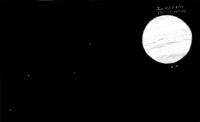 |
Jupiter - June 30, 2007
Jupiter was fantastic last night. I've been more than a little disappointed
with it so far this year. Last night I felt it was worthy of sketching. I
really liked those stretched out white bands within the Northern Equatorial
zone. I did the sketch as B&W then inverted the background. I also included
its moons because I liked the arrangement. This is a Newtonian view. |
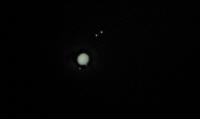
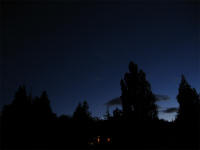
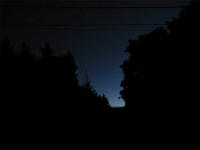 |
Venus-Saturn Conjunction & Jupiter - June 29, 2007
So even though Wednesday and Thursday nights were a bust, Friday night was
spectacular. By 2130 I was at the cricket pitch and was set up in minutes.
Oh the beauty of the Alt/Az gear. Venus was an easy naked eye sight.
Actually it had been easy to pick out at 1900hrs when I was out earlier. In
both my 6" dob and ED 80 refractor both planets were easily visible within a
single eyepiece FOV that was only a bit over one degree. This is definitely
one of the cooler things that I've seen through an eyepiece. As the sky
slowly darkened the view became even more spectacular.
I took some shots through the eyepiece with my wife's little point and shoot
that I still need to play with. You imagers know what I mean, deciding best
how to tell the lie. I also got some shots off using my old film camera.
These still await developing.
At one point when I was looking to the east and watching the Moon rise I
noticed the other gas giant blazing away so I swung my Dob around to have a
quick look. The arrangement of it's moons was quite unusual. So I fired off
a few shots with the point and shoot held up to a 12mm eyepiece. I'm
presenting my best lie of that. (Don't ask how I processed it because I
don't remember and I don't really know what I'm doing)
The other two shots are ones that I took with my wife's camera on the drive
home. The first was taken just as I turned off of Rocky Point Road. Venus
and Saturn setting into the hillside with the trees and the house in the
foreground inspired me. I stopped my truck and set up the tripod in the
middle of the street. (I actually almost got run over by someone) The other
shot was taken a little further up the road, as I was winding my way up our
hill. For it I just stuck the camera out the truck window and rested it on
the side mirror.
I actually would have like to stay at the cricket pitch to watch them set
but needed to get home. |
|
|
Venus-Saturn Conjunction - June 24, 2007
The other day David Lee mentioned the upcoming conjunction of Venus and
Saturn. I actually had stumbled upon this awhile back while playing with my
Sky program when working on a "Top 10 Planetary Nebula List" for the Amastro
group. I had just randomly pick June 30th to look at the early summer sky,
and there they were.
Sunday evening I began my pursuit of witnessing and documenting this
progression, by loading up my truck and driving my gear down to the cricket
pitch in Metchosin. This location gives me the best and most scenic view to
the west, for my area. When I arrived shortly after 2200hrs the scene was
beautiful. There was the blackened silhouette of Mount Blinkhorn against the
darkening blue sky with the glaringly bright Venus hanging in the sky above
it. Four degrees off to the east was the easily visible but much fainter
Saturn.
I had planned on doing a series of sketches but with the not very dark sky
and lack of a prominent star field in that area they will be far from
spectacular. In my opinion this will best be witnessed as a naked eye event.
The sketch that I did has the two planets at opposite sides of two of the
widest FOV that I can get with my 6-inch dob. This would place them at just
over four degrees apart. I had forgotten the 2-inch diagonal for my 80mm
refractor or I should have been able to squeeze them both in the same FOV.
Last night I remembered the diagonal but forgot to bring along a clear view
to the west. Around 2130hrs I managed a short view of the pair with the
refractor though a fleetingly short spelled clear patch. They fit just
nicely within the approximately 4.5 degree FOV at 13 X. Clouds then
completely blanketed the western sky. The view to the southeast remained
relatively clear so I decided to stay for a while. To the sounds of the
Killdeer as they flew about me I actually had the best views of Jupiter that
I've had so far this year.
Shortly before 2300hrs, prospects didn't look good, so I started to pack up.
I was about to throw my dob into the back of my truck when I looked up to
see Venus, blazing like a beacon just about to set into the top of Mount
Blinkhorn. I quickly threw the wide field eyepiece back into the scope and
was greeted by the most remarkable view. It was just like out of a Christmas
card. There was this glowing white crescent perched at the very tip of a
tall fir tree. (OK, so with the dob view it was actually hanging off the
bottom of an upside-down tree, but you know what I mean) With the addition
of the diffraction spikes I was awestruck. A short swing to the east
revealed Saturn. Between the two was a probably around 8th magnitude rather
orange star. I recognized it from the night before. I could clearly see that
Venus had moved towards this star a distance of about halfway from where it
was the night before. Three markings on a page, I guess you can call that a
sketch.
Tonight and the next few nights aren't looking all that great weather wise,
but no matter what I'll be waiting amongst the Killdeer to see what happens. |

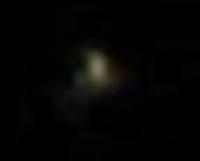 |
International Space Station & Atlantis space shuttle -
June 19, 2007 Amongst a decent sized group of people viewing the ISS
and Shuttle pass was a blast. The night sky viewing with the home schoolers
out in Metchosin was perfect in my estimation. Venus, Saturn and the Moon
with Regulus showed themselves well. Even managed to throw in a couple of
Binaries.
The climax of the evening was the ISS Shuttle flyby. They arose in the west
on cue. It was a beautiful sight. They could easily fit in the FOV of my
80mm refractor fitted with a wide field 40mm eyepiece. I was able to track
them quite easily. I even snapped off a couple of shots of each
individually. I linked them together and then rotated it. I took each shot
at exactly the same point when each entered the FOV so I'm fairly sure this
shows them with the proper separation. In the image the streaked line on the
left is the ISS and the one on the right is the Shuttle. They are heading
east which is to the left.
There is also this second image which was a shorter exposure. It was a small
point of light on the large scale. After cropping and enlarging I ended up
with this blurry image. What do you think, Shuttle or ISS? Not bad for a
hand held point and shoot shot through an ED 80mm. |
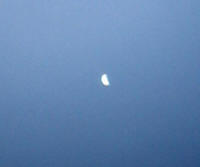 |
Venus - June 18, 2007 Earlier this evening I was
at the Village Green here in Metchosin, doing some H-Alpha Solar observing
while my son was at Scouts. Occasionally there would be a passer by who had
a look. I was also showing them Venus through my little 80mm refractor. It
was kind of funny because they would say," I don't see it I only see the
Moon." Then I would tell them, that that little crescent was Venus. Then I
would show them how to see it naked eye. I mentioned that I knew that Saturn
would be also visible but I wasn't sure where it was. Duh!
Here's how Venus looked to us through my little refractor. Photo taken with
my wife's little point and shoot. This time I actually played with the
settings. ISO 50 1/200 sec f/2.8. Simple crop. |
|
|
Vesta - June 10 & 13, 2007 Thanks to
Malcolm's
fine article on Vesta, I'd like to contribute a little. I managed (with
some difficulty I might add due to my wooded property) observations of Vesta
on Sunday the 10th and last night the 13th. For doing the observation I was
using my little 80mm refractor at only 18X. The almost 3 degree FOV made
identification easy. The fact that the asteroid is in close proximity to two
6.1 mag stars also helped in making identification easy. The third, 6th mag
dot had clearly moved in the 3 day time span. On Suday the trio formed a
very squat, drawn out V. Last night Vesta was less than a degree directly
north of the eastern of the stars. This created more of a backwards L or
check mark shape. I'd estimate Vesta to be 6th mag because the three dots
appeared almost identical. I say almost because there was a slight golden
appearance to Vesta. The two stars were white. When I increased the
magnification to 54X the golden colour increased.
If anyone is wanting to pursue this more there is a website you might want
to visit this
website, which was created to compile observations around Deep Impact.
It has now resurfaced because of the impending launch of the Dawn Mission
that will send a craft to visit Vesta and Ceres. Observations,
Images/Animations and sketches are welcomed. It is also a source of star
charts for the future. In the grey panel on the left of the page click on
Star Charts and then scroll down. Then just pick a date for a widefield
chart. On the right is a far more detailed 5*X8* chart, for if you are
having trouble picking it out of the field. |
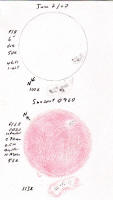 |
The Sun - Sunspot 0960 - June 2, 2007 I was
feeling pretty lazy today and doing my best to avoid yard work. I had heard
there was a pretty active region moving onto the face of the Sun. It was the
excuse I was looking for to kill a little time. Around 1600hrs I took out my
Zenithstar 80 with the old 0.5A Daystar H-Alpha filter and had a look. A
very large active area with several prominent dark spots was visible close
to the following edge. A large looping prominence was also noted almost
directly opposite on the preceding edge. No other proms were noted.
I then took out my 6" dob with a full aperture white light filter. Now I
know H-Alpha can be pretty exciting but under white light this new Sunspot,
0960 really showed what it is made of. The complexity of the region was
fabulous. I did a sketch of both views. The full surface view in white light
is at 50X and the enlargement at 100X. The H-Alpha is at 56X and 113X. I was
using my 8-24mm Nagler zoom as the eyepiece. It makes it so easy to find the
sweet spots for magnification. Holding the white light filter up to my face
I could just make out the presence of the Sunspot naked eye. |
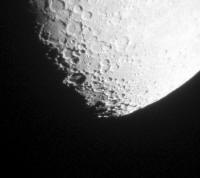 |
The Moon - Maginus crater & ray - May 25, 2007
Seeing as things were boring on the Sun I decided to do some day time Lunar
observing and this was where I had one of those light bulb going on moments.
Down close to the south polar region of the Moon is a fair sized crater
named Maginus. In it I could make out a nice Sunrise crater ray going on. In
fact, I stumbled across this ray before, a little over a year ago. I also
saw it when I was in Costa Rica just this last March. Now this is where it
gets interesting, or at least it is to me. This past March it was also seen
the day after the X (which I didn't see due to rain) happened. When I first
saw this ray it was on May 6/06. I don't know if the X appeared the day
before that date, but I do know it happened 2 months earlier on Mar 6/06
because I have a photo that I took. It's also when I did that progression
map. The X happens in 2 month cycles so I'm thinking that it probably
happened on the May date. Now stay with me, because I'm finally getting to
my point.
Do you think this Sun rise ray happens every month or is it only on the
cycle of when the libration is favorable to show the X? I guess in a month
I'll know, if the sky cooperates. I'm attaching a not very good shot that I
took of the ray in Maginus. The seeing was awful. |
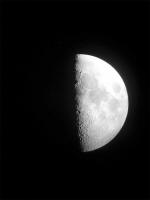
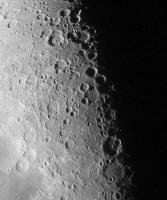 |
The Lunar "X" Feature - May 23, 2007 10:00pm-11:00pm
I took these two shots between 2200 and 2300hrs May 23/07. In the complete
Moon shot the X is really tiny and just barely visible but what is also in
the shot is the 3.9 mag star rho Leo, (the forward sticking hind foot of
Leo). The Moon skimmed just south of it. That shot was taken through my 6"
dob (I rotated the image for realism) hand holding my wife's point and shoot
to a 22mm eyepiece. The larger cropped image was through a 12mm eyepiece. |
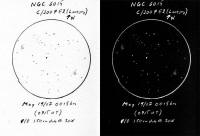 |
Comet Lovejoy C/2007 E2 and NGC 6015 - May 19, 2007
I really do need to stop looking out before going to bed. I did this around
0015hrs, so 25.25hrs after doing the sketch the evening before. The comet
had moved so much that I needed to use my 40mm eyepiece in my 6" dob to get
the entire view within one FOV. I didn't feel like doing one of my linked
FOV sketches as they take a bit longer to do. The FOV given with this combo
is approximately 2 degrees.
The previous night the comet was approx half way between the brightest star
just left of centre in this sketch and the galaxy at the far left. The
bright star in John McDonald's and
Charles Banville's images is the one
halfway between the brightest star and the galaxy. [John's] calculations say
the comet moved approx
64.4 arcmin. My sketch suggests you could add a bit of that +10% to the
calculations.
Anyway here's how I saw things last night through my 6" dob at 30X. I kind
of rushed the sketch but it's a good thing I did because clouds obscured the
view shortly after I was mostly done. I could have added a few more stars. |
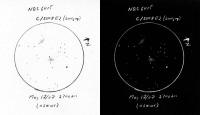 |
Comet Lovejoy C/2007 E2 and NGC 6015 - May 18, 2007
I had wanted to use the same sized scope to do the repeat observation for
consistency of image scale but I didn't. I was tired from the evening before
and had spent most of last evening helping my son study for his Provincial
chemistry exam. The thought of setting up then taking down my 12.5" truss
was more than I could take so I just set out my 6" dob. It's moments like
that, that I wished I had one of those cheapo big dobs, instead of one of
Guy's beautiful pieces of work.
The comet had moved a great deal in 24hrs. At the point of the sketch it had
moved to about 0.3 of a degree from NGC 6015. To give a bit of a
perspective, there is a star that I drew in the first sketch that lies to
the right, just outside of the rings defining the FOV. This is the star that
is now dead centre in the second sketch.
The comet was a bit more difficult to see last night but I don't attribute
that to the smaller aperture used, as I it was the same scope that I used to
observe it two nights earlier. I think it was due to the fact that the comet
was situated right beside an 8th mag star and also that glaringly bright
naked eye 5th mag star that is seen at around 4 o'clock in the sketch.
This sketch is how things were seen using a 17mm T4 Nagler in my f/8 6" dob,
for approx. 70X magnification. The FOV is a bit greater than 1 degree. |
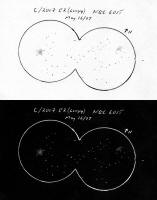 |
Comet Lovejoy C/2007 E2 and NGC 6015 - May 17, 2007
Well it's crude and could use a bit of tidying up but that will have to wait
until tomorrow. This is how I saw this conjunction tonight as viewed through
my 12.5" dob. I could actually just fit both objects within the single FOV
of my 17mm Nagler. That puts them at approximately 0.88 degrees apart. I had
to stop sketching due to a contrail. I hope someone managed to image this
tonight, it looked very cool. Coincidentally it was exactly a year ago, that
fragmented comet Schwassmann-Wachmann was making its dramatic fly by of M 13
and M57. |
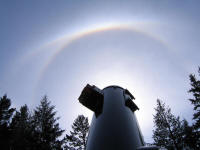 |
Upper tangent arc & Sun Halo - Apr 29, 2007 The Sun halo was
spectacular. I took the opportunity of using my scope
to apply a little art to the situation. More info on
Tangent
Arcs. |
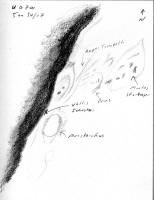
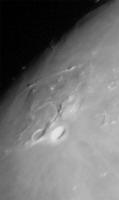 |
Moon - Aristarchus Plateau - March 12, 2007 In
March 2006 I managed to get a couple of sort of decent shots of the
Aristarchus Plateau one of which I've attached. My all time favorite of the
area though is
this one
from APOD.
This last January though, I had my most interesting view of that area. It
was one that really high lighted how dramatic the drop off is into Vallis
Schroteri. It was so odd that I did a quick sketch so I could figure out
what I was seeing. The terminator was a little to the west of Aristarchus.
Normally I see a terminator not as a true dark line but as fading into
darkness. This terminator line that I saw was as true a dark line as I've
ever seen on the Moon. It truly demonstrated how much higher the eastern
side of the plateau is than the west where Herodotus is.
This is an area that's truly magnificent to explore with larger aperture.
There are so many rilles, rupees and little mons. This attached sketch was
done using my 6" dob at 300X on the night of Jan 29/07. The seeing was
excellent.
The photo was taken Mar 12/06 with my wife's little point and shoot hand
held to the eyepiece of my little 6" dob.
The Moon is such an awesome object to observe. Chances are it will never be
the same twice unless you work at it. |
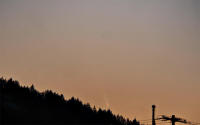 |
Comet
McNaught C2006 P1 - Jan 11, 2007 I raced around the Western
Communities to find the highest vanatage point out that way and still be
within 1/2 hr from home. I eventually ended up un a dead end street over
looking the Walmart parking lot and the Can West Mall (or what ever it's
called now). The street was packed with cars as beside me was a small hill
that a couple of dozen kids and their parents were using to tobogan into the
parking lot.
By 1620 hrs I had located the Comet with my 10X50 Binoculars then got it in
the sight of my little 80mm refractor. Even at 13X and a better that 4
degree FOV with the refractor the tail streamed out of the FOV. It took a
while but I managed to coax the first kid over to have a look. It wasn't
long before I was surrounded by children and adults alike and we had a great
old time. We chatted, passed the binoculars around, took turns looking in
the scope and just generally stared off to the West in amazement as the
Comet brightened in the sky.
On the National list the word "Great" has been attributed to this comet.
Whether it is or not I can't really say. All I know is that it allowed me to
have this absolutely wonderful moment in my life and to share it with people
I don't even know. If that isn't "Great" I don't know what is.
I'm attaching the lowly best of the bunch shot that I took hand holding my
wife's little point and shoot digital up the the 40mm eyepiece in my 80 mm
ED refractor. It has been cropped a bit to get rid of the vingetting. The
pole in the foreground had a Canadian flag on it that looked really cool
with the comet through the scope. I was hoping it would show up but it
didn't. Oh well the kids liked it. One of these days I'll have to get me one
of those fancy DSLRs. |
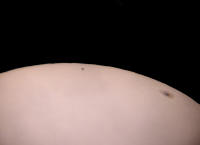
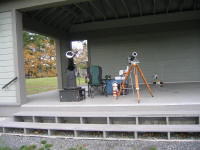 |
Transit of Mercury - Nov 8, 2006 From Metchosin I
had pretty much a similar experience with battling the clouds. I set up
under the covered stage at the Village Green, behind the Municipal Hall.
Under it's shelter I was able to observe, but would be protected from the
rain that never happened.
I first noticed a notch on the inner edge of the Sun at 11:12:56[am PST]. I
could see Mercury well visible as half a dot at 11:13:47 but then cloud
obscured the final viewing of 2nd contact.
A few minutes later The Sun was clear enough again, to attempt taking some
pictures, when a secretary from the Hall out for a smoke break stumbled
across me. I snapped off a few pictures, then showed her what I was looking
at. She went back inside but soon returned with all the rest (3) of the
office staff in tow. Until around 11:40 I managed to show them what they had
heard about on the news.
At 1:11[pm PST] cracks in the clouds again allowed me fleeting glances until
1:30 when things socked in solid. I was setup well to camp out for the whole
day with only needing to leave for a short bit around 3:00 to pick my son up
at school. I was to bring him back so we could watch the end of the transit
together. Sadly things never cleared after I picked him up, but we did wait
at the Village Green just in case.
I hadn't seen it all but did see the part that I had really wanted to and
that was the beginning. Seeing glimpses in the middle was pretty good icing
on the cake. For me at least it was a very successful transit.
This is my best photo of the bunch taken with my wife's little Canon point
and shoot. It was hand held up to a 10mm Speers WALER eyepiece that was in
my 6" dob. I had to crop it to get rid of most of the vignetting. I darkened
the background but don't really know what I'm doing, so forgive the rough
edge to the Sun. This shot was taken at approximately 11:17[am PST].
I'm also including a shot of the Metchosin Mercury Transit Camp. |
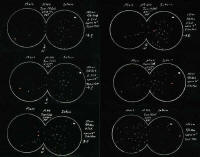 |
Mars, M44 Saturn Conjunction - June 10-18, 2006
From June 10th through June 18th, I managed total of six observations of
the wonderful merging of Mars, M44 and Saturn. This wasn�t the easiest of
tasks, due to several reasons. The first obstacle was the very late twilight
period at this time of year. This was coupled with the fact that these
objects are presently located very close to the western horizon at that time
of night. From the time they�d become visible, to their disappearing into
the distant hills I only had about an hour of time. Weather, also did its
best to conspire against me.
For three of the observations I actually headed out to the observing
location under total cloud cover. Drifting by, cracks in the clouds allowed
me enough time to eke out the location of the objects. For two of these
nights I filled in some of the stars using the sketch that I did on the
11th.
Two of the three missed observations were due to rain. The third missed
occasion (June 17th) was due to my duties as a father. My younger son and I
were at a Scout camp in Sooke, and on that evening he was running the
campfire ceremony. As the sky darkened I could see through the dense forest
that the sky to the west was clear, but I knew where I needed to be. (He did
extremely well by the way) By the time I manage to get to where I could set
my telescope up the trio had disappeared below the horizon. I did manage to
get in a good little observing session from this nice dark location though.
The panel of six sketches (inverted) chronicles the movement of Mars from
west of the Bee Hive Cluster (M44), through the cluster, then on to and past
Saturn. The linked circles are the twinning of the adjacent two-degree FOV
provided by a 40mm eyepiece in my f/8 6� dob. Start at the upper left and
move down, then go back up and read down on the right. Follow the little
pale orange dot as it moves across the field. South is up. Saturn�s movement
away from M44 was apparent, but pales in comparison to the speed with which
Mars moved through the sky.
This was a really fun project to do. |
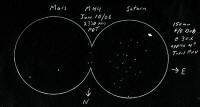 |
Mars - M44 - Saturn - June 10, 2006 - Saturday night
I setup in the heart of Metchosin on the Cricket Pitch to get the best view
to the west that I could. Despite the nearly full Moon, bright western
horizon and the wind I was able to take in a magical sight. I capture this
view at around 2330hrs PDT, as viewed through my little 6" dob at 30X with a
TFOV of 2 degrees. I linked together the adjacent fields for this sketch. I
then inverted it but retained the glistening red dot of Mars. Atmospheric
extintion and twilight obliterated all but one bright star close Mars. |
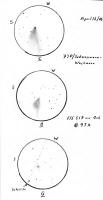 |
Comet 73P - Apr 16, 2006 - The last two nights have
offered wonderful observing conditions. On Sunday night I did another panel
of sketches while observing with my 12.5" dob. At only 93X the change in
character of the two brightest components since the beginning of the month
was dramatic. Both C and B now sport tails and the G component has entered
into the visible realm. G is just a 13th mag amorphous blob. The nucleus of
B has also become much more diffuse and the comet itself has dimmed
somewhat. Both C & B were easy targets with just the finder scope. The
attached it the sketch that I did on Sunday Apr 16. The line going across
the G sketch was a satellite that passed through the FOV at that moment. I
just thought I'd include it for realism. Just a side note in case anyone
notices, I got my E/W mixed up in the previous sketches. |
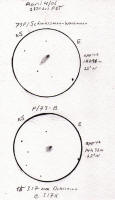 |
Comet 73P - Apr 6, 2006 - Over the past week I've
had a chance to observe this interesting periodic comet a total of three
times. It returns approximately every 5yrs. In 1995 it fractured into three
components that now travel around together. They are separated from each
other by a couple of degrees. At present the two brightest parts (B & C) are
quite easily visible telescopically as they travel through Bootes heading
towards Hercules. If you want to read more about them all sorts of
information including a very accurate finder chart is
available
here
Even with the bright Moon on the 5th I was able to find them both quite
easily with my 6" dob. The night before I'd observed them with my 12.5" dob
but was just faintly able to spot them with it's 12X80 mm finder. I'd
estimate them both to be between 9th and 10th magnitude. The attached sketch
I did using my 12.5" dob at 317X. Their movement in the sky was quite
apparent over the period of time I observed them. That star at the tip of
the coma in the top sketch was close to the pseudo nucleus 1.5 hrs earlier. |
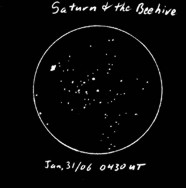 |
Saturn & Beehive Cluster - Jan 31, 2006 - Did anyone
else manage to take advantage of the short break in the monsoons? I went to
Pearson tonight for the class but no one showed. When the wind started to
blow the clouds away I was the winner. I dragged out the school's 10" dob
and put my 40mm widefield eyepiece in it. The almost 2 degree FOV it gave
just fit the bill. Jan 31st is the day that Saturn is closest to M44. It's
only 0.9� from its centre. Here is a sketch of what I saw. It was a view,
that I think I will remember forever.
Bill Weir |
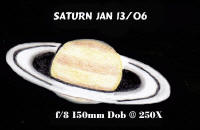 |
Saturn - Jan 13, 2006 - Friday evening I spent
almost the whole time on Saturn and produced this sketch, as viewed through
my 6" Dob. It's wonderful to see how much the tilt of the planet has changed
since last year. Now the Northern Pole section is visible beyond the rings.
A thin shadow of the planet is cast on the preceding rings and a bold ring
shadow stretches right across the planet. It was interesting to note, that
as the rings become more edge on, the Cassini Division was not discernable
on the front section of the rings. I believe some of this was due to the
less than perfect seeing conditions. |
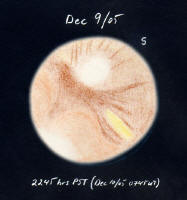 |
Mars - Dec 9, 2005 22:45hr PST - Last night I had to
go out for the early part of the evening but when I got home around 2200hrs
my little 6" Dob was already waiting for me outside. Unfortunately the Moon,
my real target, was already gone to the tall fir trees and a very thin veil
of clouds covered most of the sky. Mars rested in the only clear patch in
the sky. I didn't expect much but was pleasantly surprised. It took my
apodizing screen and red a blue filters to tease out the detail. Violet
clearing appears to be receding as detail was much more muted. I was using
powers of 200-250X. Here is what I saw. |
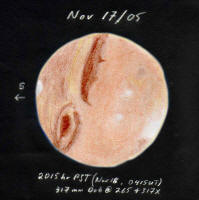 |
Mars - Nov 17, 2005 20:15hr PST- For two months
exactly I've been waiting for the opportunity to view and sketch this side
of Mars. Weather and timing both conspired against me. On the night of Nov
17th I finally got my chance. I was hoping at best to glimpse Olympus Mons.
I was delighted to not just glimpse it but actually be able to hold it
relatively steadily in my gaze. To my surprise I was also able to catch
glimpses of another white spot that to my estimation is Ascraeus Mons. The
upper of the two is Olympus and the one to the bottom is Ascraeus.
Last night I managed another sketch of the area but couldn't see them. Early
in the evening the temperature was dropping quickly and my mirror couldn't
keep up. By the time things had settled, rotation had taken care of that
area. It doesn't matter. That sketch fills in a little more detail for the
"Great Mars Map Project"
The sketch was done using my 12.5" truss dob. A few modifications were done
in Photoshop ie; curves and inversion. |
 |
Mars - Oct 29, 2005 - Last night despite the weather
I went out to Pearson College. Why, because I said I would. Also it was the
night of closest approach. You can't experience something unless you show
up. I didn't set up my 12.5" but used the schools 10" dob. That homemade
scope with its Chinese blem mirror performed very well. Mars was less of the
Warrior God and more like a small child. For about two hours I played
Peek-a-Boo with a small orange dot in the sky, as it dodged in and out of
cracks in the clouds.
The attached two sketches are what I gleaned from the event. It's not quite
the moment of closest approach but, like the saying goes,"better late than
never". Syrtis Major and Hellas are prominent at the centre of the images. A
large amount of dust was evident all over the visible side of the planet.
With dark strips of the underlying Southern Hemisphere showing through it
had the real appearance of a satellite image of a storm. South is up.
I've been playing with Photoshop and have made an attempt to add an inverted
background. I present it for your perusal. |
 |
Mars - Sept 25, 2005 - Mars as viewed through a
317mm Truss Dobsonian, fitted with an apodizing screen @317X magnification
on Sept 24/05. The two sketches were done to show the rotational rate of the
planet. The bottom one was done at 0730UT (0030 PDT) Syrtis Major is
prominent close to the meridian. The top sketch was done nearly two hours
later at 0915 UT, (0215 PDT). As can be seen Syrtis Major is well on its way
to disappearing around the eastern limb. |
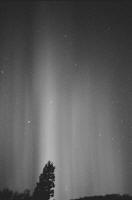 |
Aurora - July 17th, 2005 - After observing the near miss of Antares by the Moon I did a little observing in the Rossland/Trail Cemetary. Ernie was right ,they're a very nice place to observe from. A little before midnight I was treated to a nice Auroral display. I had B&W film in my camera so I decided to see what would show. I'm quite pleased with the look. It's the first time that I've tried the new B&W film that can go through the machines.
35mm SLR 55mm lens at f/2 ISO 400, approx 30 second exposure
Ilford B&W film |
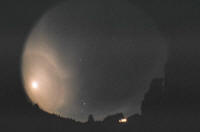 |
Moon
Halo - June 18, 2005 - Anyone else notice the Moon halo on Saturday
night? I just got my prints back. I got a bit artsy with this shot, using my
fisheye attachment on my 28mm lens. I know some of it is cut off but I
wanted to get the Big Dipper in the shot. I took this from down by Taylor
Beach in Metchosin. |
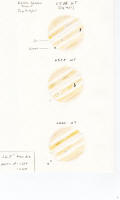 |
Jupiter Double Shadow transit - June 8, 2005, 10:38pm PDT - I saw that last night also from out here in Metchosin, at
Pearson College. It was a spur of the moment idea after noticing that this
was to occur. Too bad the lousy seeing spoiled the event. Early on the two
shadows appear merged as an elongation, until they finally split. It was
sort of like splitting the Double-Double. My favorite moment was when Europa
was in mid-egress appearing stuck to the planet's side with the two shadows
far to the other side. There were moments when Io was actually visible on
the surface. My view was using my 12.5" dob with an apodizing mask. Without
the mask Jupiter was a blur. I've attached a series of sketchs that give my
impression of the event. The final one was through a sucker hole just before
packing up. Both shadows were off the surface by then. |
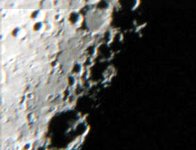 |
The X Came Back - Feb 15, 2005 - Well it did. It was fun noticing it
progress. I noticed the first illumination of the very center at around
2030hrs. By 2115 there was a full X but it wasn't really bright for about
another 1/2 hr. I took this shot around 2230hrs hand holding my wife's Canon Powershot S50 up to a 7.5mm Speers WALER in my 6" dob. By this time I
noticed that the NE arm of the X had started to elongate and fracture along
the edge of the crater it illuminated. By 2300 I had lost the view in the
tall trees.
The total view was also highlighted by the Binocular view of the Moon in the
same FOV as the Pleiades. The tiny X was visible with the 10X50s. |
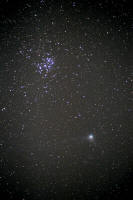 |
C/2004 Q2 Comet Machholz - Jan 4, 2005 - Ok, ignore the oversaturation in the center but it's
the best I could do with my limited processing skills and software. If I
darken it too much I loose both tails. I took this on Tuesday night out at
Pearson College with my 35mm SLR ISO 400 film 135mm lens 10 minute exposure
tracked but not guided.
I'm sure with better software the raw image could look better but I'm not
there yet. Just though David and Matthew shouldn't be the only ones doing
this. |
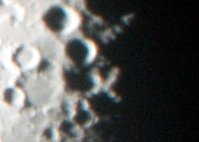 |
X Marks the Spot - Dec 18, 2004 - Bill Weir observes and photographs the "X"
feature, as described in David Chapman's letter in the Nov/Dec '04
SkyNews magazine (page 5). Bill's
Report: Tonight I was out just clowning on the Moon through the fog. Even
though the view was a bit fuzzy the seeing was actually quite steady.
Anyway, as I was moving along the terminator trying to identify craters I
came across an unusual Lunar Ray. Suddenly I remembered a recent article in
the Nov/Dec '04 SkyNews about this X shaped Ray. I dashed to the camera as
the clouds thickened and the Moon moved towards the trees. This is the best
shot of the bunch with my wife's Canon Powershot S50 held up to a 12mm
Speers WALER and my 6" dob. Time was 1950hrs on Dec18/04. It was very cool
to see.
|
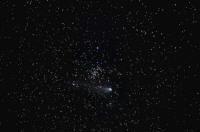 |
Comet C/2001 Q4 NEAT with the Bee Hive Cluster -
May 14, 2004 - 35mm Camera 135mm lens @ f/2.7 ISO 400 film 3
minute tracked exposure editing in Photoshop |